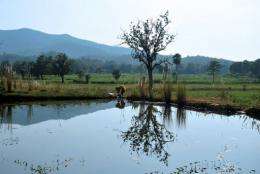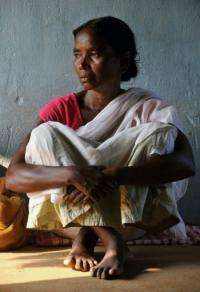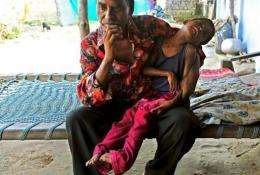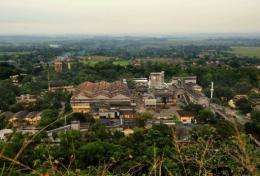India's uranium mines cast a health shadow

Gudiya Das whines as flies settle on her face, waiting for her mother to swat them while she lies on a cot in Ichra, one in a cluster of villages around India's only functioning uranium mines.
The 12-year-old, whose skeletal frame makes her look about half her age, was diagnosed with severe cerebral palsy when she was a year old.
"Back then there were 33 disabled kids here, now there are more than a hundred," her father, Chhatua Das told AFP in his home in Jaduguda valley in the eastern state of Jharkhand.
For Das and his wife Lakshmi, who have lost six children before the age of one, there is only one possible culprit -- the nearby mines run by the state-owned Uranium Corporation of India Limited (UCIL).
"I know there is some connection between the mining and what's happened to my daughter," Lakshmi told AFP. "It's because of the uranium in the water here."

Environmental groups say the mining company is polluting the groundwater by dumping radioactive waste inside three so-called tailings ponds that hold the sludge produced by the mining process -- a charge vehemently denied by UCIL.
UCIL opened its first mine in Jaduguda in 1967, and has built six more since then, providing work for thousands of local villagers in what was a deeply impoverished area.
With starting salaries of 14,000 rupees ($280) a month, jobs with the mining firm are highly coveted and bring a level of economic prosperity that adds a conflicting layer of complexity to the health risk issue.
Jharkhand is one of India's poorest states, with more than 40% of the population living on less than $2 a day, according to 2007 World Bank figures.
Ghanshyam Birulee, founder of the Jharkhand Organisation Against Radiation, believes the financial benefits are meaningless when weighed against what his group says is an alarming rise in stillbirths, birth defects, and adults and children diagnosed with cancer, kidney disease, and tuberculosis.
"How did these illnesses suddenly become so commonplace here? It's because our valley has become a dumping ground for all this nuclear trash," Birulee said.
"Jaduguda" means "magic fields" in the local language Sadri.

"These days it feels like there's black magic at work here," said Birulee, a former apprentice at UCIL who lost both his parents to cancer.
"When people first started getting sick, they thought it was because of witches or evil spirits. We had never seen anything like this," he told AFP.
UCIL firmly denies any links between its operations and any health issues in Jaduguda.
"The grade of ore is very low, so the level of radioactivity is also very low. If you are 100-120 metres away from the periphery of the tailings ponds, you face no risk," said A.K. Sarangi, deputy general manager for strategic planning at UCIL.
"We acquired land for several people here and tried to help them move, but they refused. Their intention is to extract as much money as possible from the company now," Sarangi said.
The company cites a 1998 government-funded study that found no water contamination and rejected the idea that illnesses in Jaduguda could be ascribed to radiation exposure.

Critics say the study, carried out by the Mumbai-based Bhabha Atomic Research Centre, was tainted by association with the nuclear industry, and cite a 2007 report by the non-profit Indian Doctors for Peace and Development (IDPD).
That report showed a far greater incidence of congenital abnormality, sterility, and cancer among people living within 2.5 kilometres (1.5 miles) of the mines than those living 35 kilometres away.
Mothers in villages close to the mine sites were also twice as likely to have a child with congenital deformities, it said.
The IDPD is an affiliate of the 1985 Nobel Peace Prize winning organisation, International Physicians for the Prevention of Nuclear War.
The health risks associated with exposure to uranium are well-known. According to the US department of energy, sustained exposure can result in kidney damage and an increased risk of cancer.

A few years ago, the US environmental protection agency noted high levels of radiation in homes and drinking water sources in parts of Arizona state occupied by Navajo people, many of whom worked in the mines operating there from 1944 to 1986.
Developed nations like the United States and Australia employ strict environmental standards to limit the amount of uranium released into the air by mines and processing plants.
They also require mining waste to be disposed of in a manner that limits emissions and keeps groundwater clean, by erecting fences around tailings ponds and building earthen covers to prevent any seepage into the soil.
UCIL officials insist that their mines are in complete compliance with international requirements, and that emission levels are within the accepted limits.
"We have built fences around the tailings ponds, but villagers still cut through them in parts," to take shortcuts across the land, Sarangi said.
"It is a huge area, it is just not possible to guard it all the time."
Asha Kaibart lives in a small house about 200 metres from a tailings pond.
Seventeen years ago her son Anil started to have trouble with his eyes. A few years later the same thing happened to his younger sister Sumitra. Doctors said both had sustained severe damage to their optic nerves.
Today, at 29, Anil is totally blind. He and Sumitra rarely leave the house anymore, according to their father Situ, a former UCIL miner.
"I am sure waste from the company mixes with the water we use to bathe," Asha said, pointing to a small lake nearby.
Birulee says companies like UCIL simply abdicate responsibility, refusing to help families like the Kaibarts and "threatening anyone who supports us" -- a charge that UCIL spokesperson Pinaki Roy rejected outright.
"Such allegations pain us. Our social responsibility is very important to us. After all, at least one member of each family here is working for us," Roy said.
(c) 2011 AFP



















